Developed, Offered by Groen Brothers
 James P. Mayfield , the chief test pilot at Groen
Brothers Gyros, is an inveterate gyro junkie. If it has a rotary
wing, he's there. He's also a truly good stick; and he's a
scientist. Put all that together, and you'll find a man who simply
won't take anything for granted. (That, in turn, can explain why
he's a test pilot.)
James P. Mayfield , the chief test pilot at Groen
Brothers Gyros, is an inveterate gyro junkie. If it has a rotary
wing, he's there. He's also a truly good stick; and he's a
scientist. Put all that together, and you'll find a man who simply
won't take anything for granted. (That, in turn, can explain why
he's a test pilot.)
He wrote,
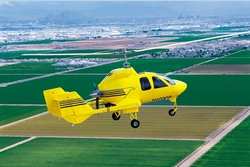 As most of you know, GBA has developed and is
marketing a turbine powered gyroplane (seen right) for use as an
observation and patrol platform. In order to develop this aircraft,
GBA recruited and currently employs an impressive array of
engineering talent. We have structural engineers, designers, stress
analyst, aerodynamic and rotordynamic engineers, manufacturing
engineers, tooling engineers, and even a metallurgist. In addition,
we employ aircraft technicians, machinists, tool setters, pilots,
flight instructors, an examiner, and of course, the people
necessary to maintain our corporate infrastructure.
As most of you know, GBA has developed and is
marketing a turbine powered gyroplane (seen right) for use as an
observation and patrol platform. In order to develop this aircraft,
GBA recruited and currently employs an impressive array of
engineering talent. We have structural engineers, designers, stress
analyst, aerodynamic and rotordynamic engineers, manufacturing
engineers, tooling engineers, and even a metallurgist. In addition,
we employ aircraft technicians, machinists, tool setters, pilots,
flight instructors, an examiner, and of course, the people
necessary to maintain our corporate infrastructure.
Through it all, we have kept a close eye on the smaller
gyroplane community. David Groen, Terry Brandt, myself, and indeed,
the entire company, are intensely interested in autorotative flight
in all its forms.
We have become increasingly distressed about the carnage that
occurs with sickening regularity in certain segments of our
community. It is also our community because we are part of the
greater gyroplane community.
 The board of directors of GBA began discussing
this abysmal safety record. Like many others, we continue to be
astounded and dismayed at the apparent disregard of the "laws of
nature" evidenced by the many fatal accidents.
The board of directors of GBA began discussing
this abysmal safety record. Like many others, we continue to be
astounded and dismayed at the apparent disregard of the "laws of
nature" evidenced by the many fatal accidents.
The event which precipitated the end of our silence, in this
matter, was the fatal crash which occurred in Ogden, Utah. The CFI
involved was the fixed wing CFI for our corporate counsel. Our
counsel asked us, "Why did this happen? Gyroplanes are supposed to
be the safest form of flight!"
We could only offer our condolences. The truth is that we at GBA
believe that sustained autorotative flight is the "safest form of
flight." But, only if the physical laws of the universe are
observed.
It was time to get involved.
The board of directors, David Groen, Jay Groen, Robin Wilson,
and I unanimously voted that GBA must do something about this
problem. The first value in our corporate value statement is:
"As a corporation and as individuals, we will always do what is
right. Doing the right thing isn't always easy. It is easy,
however, to know whether a course of action is right. If we have to
ask ourselves, 'Is this right?' we already know the answer."
We asked ourselves if it was right to stand back and watch
events occurring which we had the power to help preclude. We
already knew the answer. --JM
Upgrade for the popular RAF 2000:
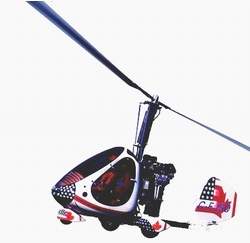 Effective immediately, GBA will begin offering a
professionally-designed and -manufactured Stability Augmentation
Retrofit Kit for the RAF 2000. Kits ordered now will be delivered
or installed during late January, 2003.
Effective immediately, GBA will begin offering a
professionally-designed and -manufactured Stability Augmentation
Retrofit Kit for the RAF 2000. Kits ordered now will be delivered
or installed during late January, 2003.
The kit will consist of:
- A composite tall tail assembly with an integral nonsymmetrical
horizontal stabilizer.
- A drop keel cluster plate assembly with hardware.
- A welded steel tube landing gear with suspension.
- A PSRU mounting plate to allow inverting the PSRU.
The cost of the kit will be $4935.00. Groen
Brothers will install the kit at their Buckeye (AZ) facility
for an additional $2000.00.
More upgrades available:
A composite airfoil, similar to the airfoil on
the Hughes 300, to be mounted at the top of the cabin to help
eliminate cabin pitching moment with speed increase. This device
with hardware is priced at $450.00
Double bearing rotorhead retrofit service. The
customer will send his rotorhead to GBA, and they will
disassemble, clean and inspect the rotorhead, install a double
bearing block, new bearings, and new teeter towers and ship the
unit back. This service will be $400.00. This service will
be offered for all brands of offset gimbal rotorheads.
Other products and services, including the
development of stability augmentation kits for other aircraft,
offset gimbal rotorheads, a collective pitch rotor head, and
possibly, a kit and/or a Sport category aircraft, are being
considered.
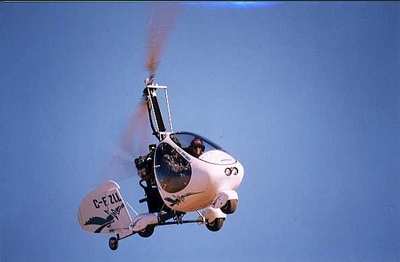
Gyro flight training, too:
Also offered, in Arizona:
- Flight training in customer aircraft at $45.00 per hour. (Groen
will not conduct training in non-centerline thrust, yaw unstable,
non-horizontally stabilised machines.)
- Flight training in their modified RAF at $120.00. This service
will begin during mid-January, 2003.
- Gyroplane rating practical tests at $250.00 (plus aircraft
rental if applicable).
Mayfield continued, "The decision to offer these products and
services was difficult. Allocating the engineering resources
necessary to professionally design and manufacture this kit was
painful. The risk of diverting us from our primary task was
carefully considered before choosing this course of action. We
simply felt we had no choice."
We talked with Don LaFleur at RAF.
 "One takes it all with a grain of salt. James
Mayfield has flown our machine, with and without the equipment like
what he's putting on... In fact, we have our top five or six
pilots -- over 10,000 hours in the RAF 2000 -- and not one of them
is using these contraptions."
"One takes it all with a grain of salt. James
Mayfield has flown our machine, with and without the equipment like
what he's putting on... In fact, we have our top five or six
pilots -- over 10,000 hours in the RAF 2000 -- and not one of them
is using these contraptions."
We talked for a moment about Light Sport Aircraft --
Sport Pilot.
"Sport Pilot shouldn't be about specifications -- it should be
about performance standards. If the gyro community cannot
come up with a standard, we'll all be in trouble. The dangerous
thing that happens in the industry -- people always want to
downplay the need for training. People too often treat this as
a toy."
"We in the industry need to work together. The major
problem in the industry is, and remains, training. Guys come into
this, and think it's a little toy -- that they could just jump in,
take a couple hours' training, and fly."
Training, training, training!
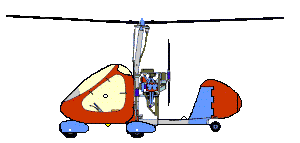 Training is
an improvement, regardless the machinery. Machinery is a means to
an end; training, regardless the machine, makes you a better
flier. "We have thousands of hours of flight time here. We've
flown over 130 mph, and in winds, without the horizontal
stabilizer." The ultimate performance, and safety, is in the
pilot's seat.
Training is
an improvement, regardless the machinery. Machinery is a means to
an end; training, regardless the machine, makes you a better
flier. "We have thousands of hours of flight time here. We've
flown over 130 mph, and in winds, without the horizontal
stabilizer." The ultimate performance, and safety, is in the
pilot's seat.
As for Groen Brothers' effort, "I don't argue
the point with them -- it's more-technical than most in the
industry will admit... Groen Bros are basically working on the
fears and suspicions of the people in the industry. If they want to
produce it, more power to them.
"The reason we don't redesign somebody else's product (we'll
sell them parts; but we caution them to talk with the designers of
their own aircraft): we don't want to redesign somebody else's
product. Every aircraft has its own merits. The one thing that
applies to everybody -- inexperienced pilots (I mean
rotorcraft pilot) have the makings of a crash on their hands. How
the pilot fares is how severe the crash is. I have a lot of respect
for Groen Brothers. What they plan to do, I don't know -- if it's
going to make it better or not, I don't know. I'd like to see the
flight-test data."
Reserving judgment...
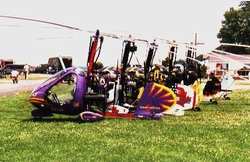 "I haven't seen what they're doing; I haven't
flown the [modified] aircraft. We have a 1/4 scale model flight
test system, that gives you frame-by-frame recordings. I have video
of plenty of other gyroplanes doing a power pushover. There are
multiple videos. It has a lot to do with what the pilot is doing. I
think any of these aircraft can do a power pushover. Our testing
says that every last one of these machines can do it; it comes down
to the pilot's ability. If you fly near the max capability of the
aircraft, with a minimum-control pilot, they'll be in trouble. The
training needs to be more and more intense -- like Frank Robinson
did with his R-22."
"I haven't seen what they're doing; I haven't
flown the [modified] aircraft. We have a 1/4 scale model flight
test system, that gives you frame-by-frame recordings. I have video
of plenty of other gyroplanes doing a power pushover. There are
multiple videos. It has a lot to do with what the pilot is doing. I
think any of these aircraft can do a power pushover. Our testing
says that every last one of these machines can do it; it comes down
to the pilot's ability. If you fly near the max capability of the
aircraft, with a minimum-control pilot, they'll be in trouble. The
training needs to be more and more intense -- like Frank Robinson
did with his R-22."
Compare and contrast:
Don continued, "I see student pilots --
they respect their C-152. They don't mess around
with it; they do it by the numbers. Take that same person, put
him in the gyroplane that he built himself, and he'll start fooling
around in the trees. God gives us free choice: ultimately, the
pilot makes the decision to do the things that he does. I don't
care how much fixed-wing time a guy has -- if you get into
turbulence, hit microbursts -- you can get into trouble, fast."
Advice to prospective fliers:
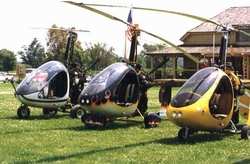 Don is adamant about opening the eyes of pilots,
to the merits of doing the homework: "Get two or three hours before
you even decide if you want to start: you'll learn if you even want
to do it, in the first place. Second, in you own mind, your own
heart -- you'll know if you think you can handle the flight
characteristics of a rotorcraft; and then you get a chance to see
the quality of the product you're going to fly in."
Don is adamant about opening the eyes of pilots,
to the merits of doing the homework: "Get two or three hours before
you even decide if you want to start: you'll learn if you even want
to do it, in the first place. Second, in you own mind, your own
heart -- you'll know if you think you can handle the flight
characteristics of a rotorcraft; and then you get a chance to see
the quality of the product you're going to fly in."
ANN Note: My personal estimation
of Mr. LaFleur's credibility on this issue is not very
positive. However, rather than belaboring that, we urge all those
with questions about the safety of this aircraft to spend some time
reading the discussion boards at the wonderful www.rotorcraft.com
rotorcraft site (a must for sport rotorheads... one of the most
constructive efforts we've seen in this part of the industry).
There, the RAF question is discussed in detail and a LOT of
evidence may be seen and judged appropriately. As far as we're
concerned, Mr. Mayfield's efforts are a positive reflection on the
professionalism and dedication of he and his staff... and we
congratulate them for taking this step to enhance aviation
safety... Jim Campbell, ANN Editor-In-Chief
 Aero-News: Quote of the Day (04.27.25)
Aero-News: Quote of the Day (04.27.25) ANN's Daily Aero-Linx (04.27.25)
ANN's Daily Aero-Linx (04.27.25) Classic Aero-TV: Veteran's Airlift Command -- Serving Those Who Served
Classic Aero-TV: Veteran's Airlift Command -- Serving Those Who Served Airborne-NextGen 04.22.25: NYC eVTOL Network, ForgeStar-1, Drone Safety Day
Airborne-NextGen 04.22.25: NYC eVTOL Network, ForgeStar-1, Drone Safety Day Airborne 04.21.25: Charter Bust, VeriJet Woes, Visual Approach Risks
Airborne 04.21.25: Charter Bust, VeriJet Woes, Visual Approach Risks










